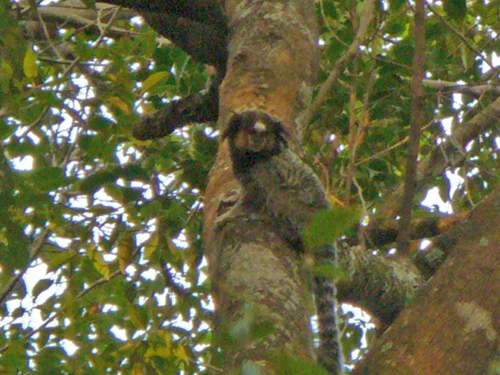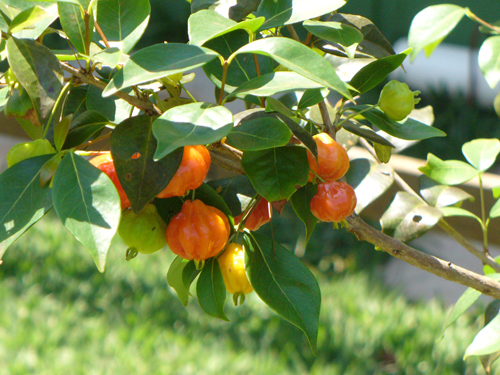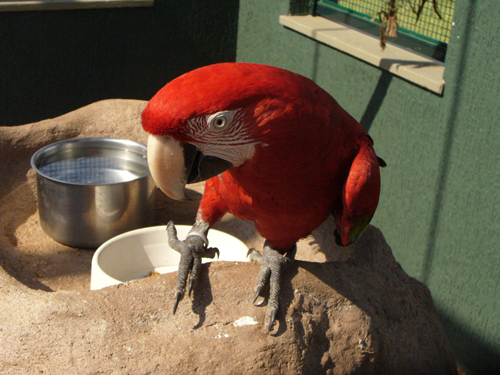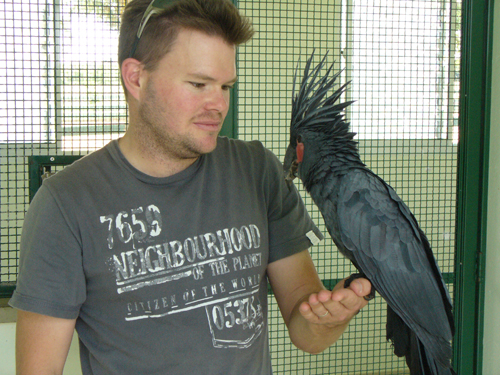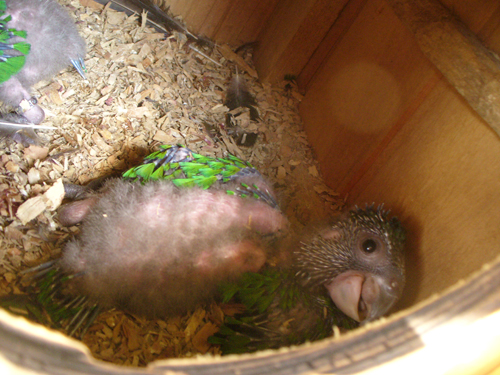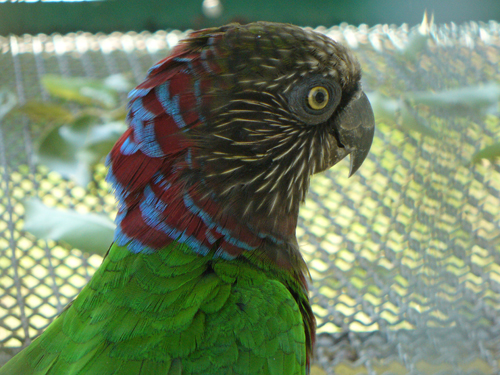The change is abrupt. I urge my shaky rental over the last of the rocky red road, out from under the cooling shade of the tree canopy, into the brilliant sun and onto the Brazilian highway. My mind and heart are achingly full of my recent experience visiting Bill and Linda Wittkoff at the Lymington Foundation, a refuge and breeding facility for rare parrots hidden away in a privately owned rainforest haven near São Paolo. My awe only grows stronger as I travel further away from the forest--awe and amazement at the rich surfeit of wildness and love hidden away in this remote corner of the world. Eventually however I manage to tuck these reflections into a corner of my mind and brace myself for the next adventure.
My next destination is another breeding facility for endangered birds located approximately four hours' drive from São Paolo known as "Nest." I know nothing about it except that it is home to four of the five Spix's Macaws residing in their native Brazil*--the fifth of course being Presley, the Spix's Macaw residing at Lymington (for more about my visit to Presley and the Lymington Foundation see my article, "Brazil, Land of the Spix's Part I"). I have been invited to visit Nest by Ryan Watson, project manager for Al Wabra's Brazil Project, whom I got to know while researching Presley and his story. As the GPS guides me along my path, the landscape gradually transforms into an oddly familiar scene of rolling golden hills and dry agricultural fields. I realize that it is uncannily similar to of my native home in northern California, many thousands of miles north on the globe. My drive is punctuated by toll stations and evenly spaced emergency phone booths. At one point I have to come to a complete stop on the freeway to allow a pedestrian to cross at a crosswalk. No, this is not California.
* Unfortunately the Brazilian government prohibits public posting of images of Spix's Macaws without express permission, so I cannot share my photos here.
I stop at a forlorn gas station with unpaved dirt surface surrounded by sparse thirsty vegetation. It seems straight out of the Old West--I almost expect a tumbleweed to come rolling. I make a 90-degree turn off of the highway onto a driveway signed "Estância Andrea" and ring at the gate as instructed. The gatekeeper points me towards a parking lot where I tie up my exhausted rental and wait. I survey my surroundings, which are mostly flat, sloping gently down towards a lake just out of sight. The air is soft and warm as bath water. Fat spotted ground fowl the size of turkeys are roaming around freely, and I spot the tops of what must be the aviaries over a tall hedge in the distance.
Soon a golf cart pulls up next to my car. It contains two people who introduce themselves as Gastaõ Zanirato and Andrea Guimarães, the owners and proprietors of the Estância Andrea (Gastaõ named his estate after his wife). We are soon joined by Ryan Watson and his wife Monalyssa, also a conservation biologist, driving another golf cart painted with parrots on the side. I bid goodbye to my car and load my suitcase in Ryan's cart for a tour of the estate. We drive first down to the lake, which I now realize is a man-made reservoir--another echo of my native California. The estate consists primarily of open fields, with individual trees planted at intervals. Ryan bumps us over the grass to get closer to one grove of especially tall trees, explaining that there is a tribe of monkeys that often frequents the grove. I can hardly believe it--I have never seen a monkey outside of a zoo! We see no monkeys but I make a mental vow to return on my own for a second try.
Wild monkey
Everywhere on the estate there are support systems for the local wild birds--bird houses, bird feeding stations, and bird baths. I can't keep up with all of the new species I am seeing and I am dizzy from the number of times I have to turn my head to see a new and amazing bird. Everyone is taking full advantage of the free handouts. Ryan explains that many of the trees planted on the estate bear native fruit for the benefit of not only the wild birds but also the captive population here at Nest. He regales me with tales of the birds to be seen here--nightjars, ibis, and even toucans. Am I in a fairy tale, I wonder--monkeys, toucans! He pulls out his iPod and plays recorded calls of various birds in case I hear them later. We pass many structures to harness solar and wind power--testaments that Andrea and Gastaõ are devoted stewards of this small patch of environment under their care.
Local native fruits
By the end of the tour I realize that Estância Andrea is perhaps best likened to an eighteenth-century European estate: a large tract of land with a house for the owners, guest quarters, expansive gardens, and smaller houses for the people that work here such as the Watsons who are assisting with the management of the Spix's and other birds. But most importantly, the land serves the hobbies and interests of its owners--Gastaõ's fascination with model airplanes, for instance--and Andrea's passion for endangered birds.
We drive up a brick-paved avenue and approach what appears to be a row of storage units. The golf cart stops and I realize they are actually the guest quarters--a row of four ultra-modern rooms bisected by an open-air kitchen. The doors are sliding glass, but are secured by rolling metal garage-style doors. When closed, they seal the occupant in a white, clean, climate-controlled space. Quite a contrast to my rainforest villa at Lymington, whose doors and windows provided at best an imaginary barrier to the surrounding forest and its wild denizens. I wash up in a futuristic bathroom and tentatively test a refrigerated Brazilian beverage provided by Ryan--delicious, but utterly mysterious as I can't decipher the Portuguese on the box.
Afterwards I lie on the cold sheets and miss the Wittkoffs and their rainforest paradise. I try but cannot understand the force that created such a strong bond so quickly with those people and that place--and I realize with a hole in my gut that, had I stayed another twenty-four hours, I might never have left.
I have been invited to dinner at what I think of as "the big house"--Gastaõ and Andrea's personal house, which despite their obvious wealth is impressively modest--nothing like the size the great houses of Europe, but instead reminiscent of a house one might encounter in an upscale American suburb. The architecture is very modern, with a giant kitchen and eating area which open onto a poolside patio; there we enjoy a potent concoction fashioned by Gastaõ out of rum and the juice of some unfamiliar Brazilian fruit. Giant black beetles have emerged to enjoy the night with us, and the constellations of the southern hemisphere slowly light up. My hosts attempt to point out the Southern Cross which I have never seen. A chef has prepared our meal which we eat at a simple round table, entertained by the antics of the beetles and the Watson's tiny daughter. Once again I marvel at the contrast between this place and the Wittkoff's rainforest home where I was only this morning. No hand-built house, rudimentary electrical system, or appliances dating from the 1950's--instead futuristic architecture, servants, and impeccably clean white floors. The reused coffee filters of Lymington are replaced here with a pod-fed, state-or-the art espresso machine. A cake made by the chef sits protected under a screened cover from six-legged predators.
Andrea's companion Scarlet Macaw
I walk back to my guest quarters after dinner just in time to see a flock of huge birds silently land in one of the stand-alone trees. I learn later from Ryan that they are buff-necked ibis: giant crane-like birds that fly back to roost in the same tree every night. Back in my storage unit I lie between the sterile sheets and listen for nightjars. Suddenly I hear a strange, rhythmic knocking sound. I eventually realize it is one of the giant beetles, methodically bumping against the metal door, determined to find a way inside.
The next morning I cannot resist the lure of the monkey grove. I wander towards it on my way to my breakfast appointment with Ryan. As I near the trees, I startle two large toucans who fly off over an adjoining row of trees and out of sight. I am wild with delight to see these majestic creatures flying free--it seems really that they should not be able to fly at all, with those giant beaks. I tread softly among the trees and sure enough, I spot a tiny lion-faced monkey gazing curiously down at me. I stare back, transfixed, until it loses interest and joins the rest of the troop as they move through the trees, leaping and scurrying about like squirrels. I join Ryan afterwards, effusive about my good fortune, and he explains to me that toucan beaks are indeed huge, but are very light and airy inside, enabling the birds to fly unencumbered. The two of us eat a lovely, chef-prepared breakfast of tropical fruits, toast, and of pod-brewed espresso. Ryan then conducts me on a comprehensive tour of the bird-related projects here on the estate. He shows me the construction in process on a veterinary facility which will attend the Nest birds. We visit majestic Palm Cockatoos who eat out of Ryan's hand and attempt to gnaw on his shoelaces. We visit four Jurassic-Park sized aviaries which are intended to house the severely endangered Lear's Macaws. These aviaries would not seem out of place in Disneyland with their desert theme, artificial red rocks and fountains. The far walls have been constructed to mimic the cliff walls and caves in which the Lear's prefer to nest, with dimensions specifically crafted according to what the macaws seem to prefer in the wild. No Lear's have yet arrived, so the lone inhabitants of the aviaries so far are Andrea's original two pet macaws, who seem a bit dazed and unsure what to do in their palatial surroundings.
Ryan Watson with a Palm Cockatoo
At last we arrive at the main aviary grounds where Andrea joins us. Surrounded by protective hedges, it comprises a grassy square framed by rows of large green aviaries and their brightly colored denizens. I know that some of these aviaries contain the rarest of all the parrots, the Spix's Macaw. They are an unseen, exciting presence. We pass raucous Sun Conures, bright red and green Eclectuses, and a huge aviary in the center housing a gorgeous Hyacinth Macaw. Many of the parrots loudly defend their territory as we pass by, chasing us along the length of their aviaries until we are out of reach.
We stop at an aviary for Hawkheaded parrots, where Andrea climbs a ladder to peek in at an active nest box. I am allowed to peek in as well, and am thrilled to see two fat chicks like little colored porcupines lying passive and vulnerable in their nest.
Hawkheaded Parrot chick
Hawkheaded Parrot adult
The aviaries themselves are impressive structures of generous proportions. They are of strong metal construction with potted plants and branches, nesting accommodations, and plenty of room for flight. Trees with red and orange fruits and berries are interspersed among the aviaries, laden with native food for the birds.
At last, we arrive at Nest's most precious resource, the aviaries holding four of Brazil's five Spix's macaws. Extra security is plainly visible on their enclosures. Two pairs of macaws reside in two neighboring aviaries, both of which are sterile. Plexiglass windbreaks between the two aviaries protect the birds from strong breezes but also from potential contagion should either pair become ill. The birds seem happy to see us, and Ryan allows me some precious time inside the aviaries. The birds eye me curiously but are clearly used to humans and don't seem to mind as I take innumerable pictures and admire the heck out of them.**
** Since my visit in October of 2012, six additional Spix's have been transferred from the Association for the Conservation of Threatened Parrots (ACTP) holding in Germany to the Nest facility.
The Spix's are incredibly gorgeous creatures with their sky-blue plumage fading into gray like dawn on a stormy morning. I am pleased to observe how happy and healthy they appear--blissfully unaware of their species' predicament, more concerned with whether or not we have brought treats (Ryan explains that the birds get a nut treat at the end of the day and are no doubt expecting something similar from us). Years of scientific research has gone into the aviary and nest box construction as well as the birds' diet. Obviously everything possible is being done for their well-being and comfort, with no expense spared.
I ask Ryan about the plans for Presley, who was originally slated to be transferred to Nest to join the other Spix's here. He describes a special aviary being designed for him which will be able to accommodate his inability to fly and keep him safe from dangerous falls while still providing flying space for his future companion--possibly his old mate Flor. The hope is that new advances with artificial insemination may allow Presley to father chicks--albeit at a distance. (Sadly as I learn later, these plans are all on indefinite hold.)
Andrea bids us goodbye and Ryan, Monalyssa and I sit in the shade of a kiosk near the Hyacinth enclosure. We discuss the fate of the Spix's, now resting quietly in their aviary just yards away. Ryan unveils many changes in store for the species. The Al Wabra collection in Qatar, home to the vast majority of the Spix's population, is in the process of being transferred from the private ownership of Sheik Saoud Bin Mohammed Bin Ali Al Thani to the Qatari government. Ryan sees this as a positive step, reducing the need to cater to individual desires and whims in the decision-making process.
Ryan is also heavily involved with the ongoing effort to reestablish a wild population of Spix's macaws in Brazil. The land has been acquired, the infrastructure is in the planning stages, and the local people are being educated on the importance of the project. What remains is to test the viability of the plan with trial runs using the more common Illiger's macaw, and, most importantly and most difficult, to restore the Spix's population to healthy enough numbers that the loss of even one individual does not pose a significant threat to the survival of the entire species. One idea put forward has been to conduct trial releases using some of the sterile females--individuals incapable of reproducing due to their heavily inbred genes.
The lessons I learned at Lymington strike me with even greater force as we talk: that at this pivotal point, it is only humans--and science--that can rescue the Spix's Macaw and other extraordinary species from extinction. The birds are utterly dependent on humans to increase their numbers, diversify the genetic pools, and keep them healthy and safe. It is the ultimate irony; through poaching and habitat destruction, humans created this tragedy. Now only humans can rewrite the drama.
Not all is bleak on the horizon, however. Plans for the Spix's reintroduction into the wild are going full force ahead, if slowly. Ryan and Monalyssa have relocated to the caatinga region where the release will eventually take place and are overseeing the establishment of a research facility there. And recent successes with artificial insemination of Spix's Macaws have the potential to better safeguard what little genetic diversity remains in the population.
After we finish our discussion, Ryan and Monalyssa head back to their house on the estate, and I linger behind to visit the four Spix's alone. I stand outside the bars of the aviaries and look into their eyes. Twilight is setting in and the birds eye me hopefully for their treats. I am struck again by how very human parrots are, by how much understanding there is between us. It is as if they are allowing us to care for them--but only with their permission, as if they know it is a temporary state. At heart they remain wild, and belong in the wild. We will see if the best efforts of well-meaning humans will be able to make this once more a reality.
----
Special thanks to Ryan and Monalyssa Watson, Andrea Guimarães, Gastaõ Zanirato, Bill and Linda Wittkoff, and all who continue to devote their lives to the cause of the Spix's in the face of great odds and with an unshaken faith that their efforts will make a difference.




